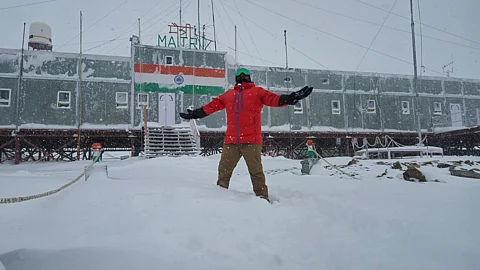
- HOMEGROWN WORLD
- #HGCREATORS
- #HGEXPLORE
- #HGVOICES
- #HGSHOP
- CAREERS
- ABOUT US
- CONTACT US

In John Carpenter’s 1982 sci-fi classic 'The Thing', a team of scientists stationed in Antarctica find themselves battling a shape-shifting alien lifeform, their isolated research base descending into suspicion and madness. At India’s Maitri research station, the stakes are different — there are no extraterrestrial horrors lurking in the snow (we hope) but the premise isn’t far off. A remote group of specialists, extreme weather, total dependence on one another for survival, and an environment so hostile it might as well be another planet. Except instead of fighting aliens, the crew at Maitri conducts invaluable scientific research, keeps complex systems running, and finds strange comfort in Maggi packets and movie nights.
Established in 1989 to replace the sunken Dakshin Gangotri, Maitri is India’s second permanent Antarctic station, located in Queen Maud Land's rocky Schirmacher Oasis and built on steel stilts to withstand shifting ice. Under India’s Antarctic Programme (operated by NCPOR), Maitri conducts research in geology, glaciology, atmosphere science and cold‑region engineering — studying everything from Gondwana’s ancient rocks to modern polar technology.
For Dr. Rahul Jain, the medical officer stationed at Maitri, the allure of Antarctica was part adventure, part purpose. “I’ve always had this urge to step beyond the ordinary,” he says, describing the move from hospital corridors to polar winds as both a professional challenge and a deeply personal experiment in growth. He imagined a quiet, white wilderness, maybe even a bit lonely. The reality, he says, was far more intense in two months each of polar day and polar night at Maitri, which is located about 3,000 km from the South Pole.
At Maitri, even a brief step outside requires calculation. “You don’t just walk out of the station — you prepare,” Rahul explains. The cold is dangerous, with humidity levels plummeting to 20 percent and temperatures capable of freezing prescription glasses within ten minutes. Layering is a science in itself — three insulating layers, gloves, boots, goggles, face masks, a buddy system, and a radio. Exposure can numb any uncovered skin in minutes.
And yet, the rhythm of daily life persists. Rahul’s mornings begin at 7:30 AM with stretches, water, and a check on his teammates’ health, followed by breakfast and the day’s assignments. Everything depends on the weather, with tasks ranging from fieldwork and sample collection to waste management and instrument checks, all tightly scheduled around fluctuating conditions.
Inside Maitri, life revolves around small rituals — hot chai, filter coffee, community workouts, Carrom tournaments, TT matches, foosball, movie nights, and singing old Bollywood songs. “It’s strange how routines become survival tools out here,” Rahul notes. One of the most comforting of these rituals is food. “Our kitchen is the warmest corner of Maitri — literally and emotionally.” With fresh supplies arriving only once or twice a year, the station’s kitchen staff pull off small miracles with frozen peas, soya nuggets, and spices. Tuesdays bring sweets — jalebi, halwa, dry fruit laddoos, a burst of memory and morale packed into a dessert. On stormy days, the act of splitting the last Maggi packet becomes a moment of bonding.
Rahul describes Maitri as a kind of mini self-sufficient town, where every person plays a vital role in keeping the station running. There’s a station leader who oversees and coordinates everything, and a team of scientists — Meteorologists, geo-magnetists, geologists, glacier-ologists, microbiologists, biotechnicians, lab technicians — who carry out the core research. A dedicated workshop crew comprising a crane operator, OEM, vehicle mechanic, electrician, welder, and carpenter ensures that all vehicles remain in working condition for convoys, whether they’re headed out for fieldwork or supply runs.
Engineers maintain the station’s power systems, plumbing, and machinery. There’s also a chef, a communication expert, logistics staff, inventory managers, and, of course, two doctors and a nurse. Each person brings deep expertise in their domain, but beyond that, everyone remains ready to help wherever needed.
Should someone ever get the rare chance to visit Maitri, Rahul has his dream itinerary planned. The ice wall near Schirmacher Oasis would be the first stop. Then, a hike to a nearby frozen lake shaped like the Greek letter Omega, especially at sunset when the blue-white light transforms the landscape into something otherworldly. If you’re lucky, you might catch a halo around the sun — an optical phenomenon rare even by Antarctic standards. There are ice caves to crawl into and quiet spots like the library and prayer room; places for peace or perspective. The day would end back in the mess with a warm jalebi and the wind howling outside. "That's the real Antarctica experience," he insists.
But, as the doctor reminds us, getting permission for a station tour is nearly impossible. And perhaps that’s part of the allure — the sense that this place belongs to a few who are willing to endure its extremes and build a home at the edge of the world.
Follow Rahul here.
